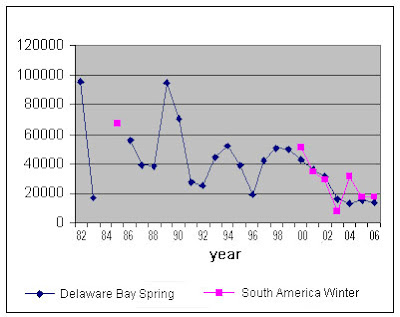The decline of Red Knots from 1982 to 2006: data from Niles et al. 2007. Status of the Red Knot (Calidris canutus rufa) in the Western Hemisphere. USFWS report.
data from Niles et al. 2007. Status of the Red Knot (Calidris canutus rufa) in the Western Hemisphere. USFWS report.
The Red Knot and Horseshoe Crab story has been in the news in the last several weeks, with a major PBS documentary “Crash: A Tale of Two Species“, and the New Jersey Marine Fisheries Council’s ludicrous decision to reopen a limited harvest of Horseshoe Crabs in the state (newspaper stories about that can be found in the Press of Atlantic City and the Philadelphia Inquirer).
Now the good news is that the NJ state legislature is considering a ban on Horseshoe Crab harvest, and we should all encourage them to follow through.
Call or write to New Jersey’s State Senators before March 10th, as they are considering a ban on Horseshoe Crab harvest in the state (to over-rule the Marine Fisheries Council vote). Visit the NJAS website for details.
Also, in late Feb 2008 nine conservation groups and three US senators signed letters to the Department of Interior urging the emergency listing of Red Knot as an endangered species (details here).
Here is a summary of some key facts:
- numbers of North American Red Knots counted on Delaware Bay surveys have declined from over 100,000 in the early 1980s to only about 14,000 in 2006.
- These knots nest in the arctic, winter in southern South America, and make long non-stop migration flights, stopping in spring primarily at Delaware Bay where they refuel on the eggs of Horseshoe Crabs.
- Harvest of Horseshoe Crabs for use as bait in eel traps has led to a drastic decline in spawning crabs (and eggs) on the beaches since the late 1980s.
- Migrating Red Knots now have trouble finding enough fuel for their long migration, and (if they reach the breeding grounds) it is thought that most are unable to nest successfully.
It is estimated that the effective breeding population of the eastern North American subspecies of Red Knot Calidris canutus rufa, is now only 1000 to 2000 birds in any given year. These are the numbers that lead researchers to suggest that the subspecies may be extinct within just a few years (from the 2007 Status Assessment available as a .pdf here).
What you can do:
Call or write to New Jersey’s State Senators before March 1oth, as they are considering a ban on Horseshoe Crab harvest (to over-rule the Marine Fisheries Council vote). Visit the NJAS website for details.
Support the Delmarva Ornithological Society’s Birdathon efforts to raise money to purchase bayfront property as a shorebird sanctuary.
Write to the Governors of New Jersey and Delaware stressing the importance of this natural resource to their states. Delaware needs to enact a ban as well to ensure protection of the Delaware Bay crab population. And hopefully a broader regional plan can be put into place so that the crab harvest pressure is not simply diverted to other states.
Other Resources:
Atlantic States Marine Fisheries Commision
US Fish and Wildlife Service Red Knot info with links to lots of information including the July 2007 Status Assessment (a 16 MB .pdf file, but well worth reading)
New Jersey Division of Fish and Wildlife Red Knot page, also with links to the status assessment and more
The Ecological Research and Development Group, which has been working on alternatives to Horseshoe Crabs as bait

